Learn how to make a classic remouillage of rewashing already used bones to make a delicious stock that can be used for soups, stews, or sauces. You will love how economical and convenient this is by getting the most out of what you already paid for.
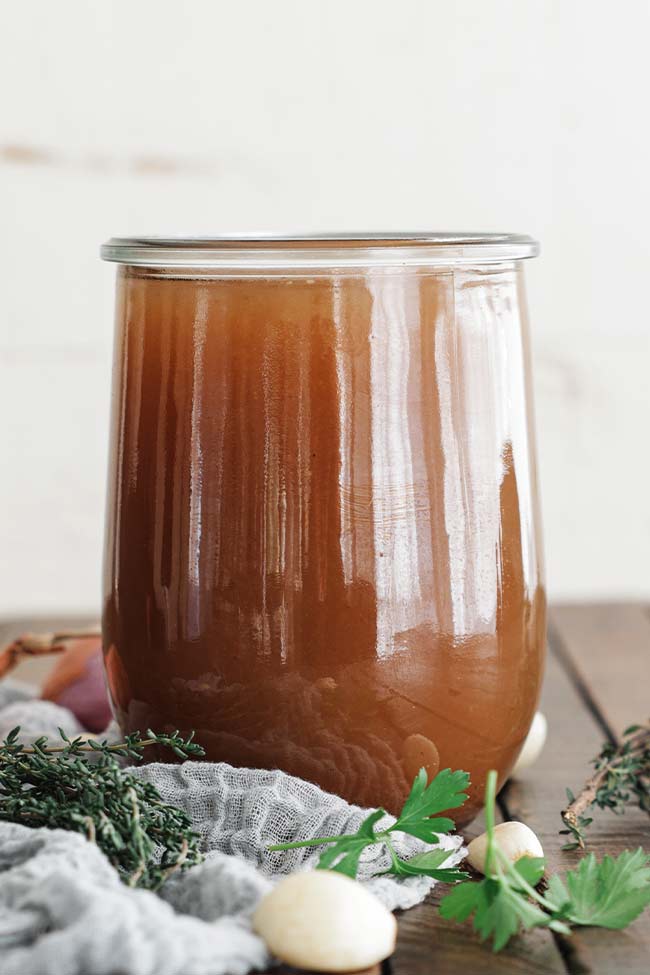
I used stock in so much of my cooking that it became second nature. It can turn a bland dish into a brilliant one. If you want to try this remouillage in other recipes, use it in my mushroom sauce or this slow cooker pot roast.
What is Remouillage
Remouillage is a stock made from bones, mirepoix, spices, and herbs that have already been used to make stock. The term itself translates in French as “rewetting.” In the restaurant industry, we often call it a second wash stock. Believe it or not, there is still a lot of flavor and gelatin to be extracted from the bones even after they have been used. While this is more commonly made from veal or beef bones, you can also do this technique after making chicken stock.
Of course, the end result will not be as flavorful or clear as the first stock, but it still has plenty of usage. This procedure allows you to get the best bang for your buck and will virtually double your stock amount. In fact, once our first stock and remouillage were completed, we would combine both and use them in soups, stews, and small sauces.
Ingredients and Substitutions

- Bones – This recipe requires veal or beef bones to be used only once for stock. The bones will look a little beat up but still have plenty of collagen for a second stock.
- Onions – Yellow, white, or sweet onions are suitable for this. Whole garlic cloves are also added to the stock.
- Celery – Some fresh celery is an integral part of mirepoix and will help add flavor to the final liquid.
- Carrots – Any color, peeled or unpeeled, are a great addition to the remouillage.
- Herbs – I used fresh thyme sprigs and Italian flat-leaf parsley stems. However, you can substitute the fresh thyme for 1 ½ teaspoons of dry thyme and the fresh parsley for 2 teaspoons of dry.
- Spices – Peppercorns in any color can be used in the stock.
- Additional Items – Of course, some leftover vegetables, tomato paste, spices, and herbs from the first time the stock was made will remain, and it is entirely okay to leave all of it in the pot.
How to Make Remouillage
Start the remouillage: Once I’ve completely drained the first stock, I return the bones, cooked mirepoix, spices, and herbs back to the pot on the stove.
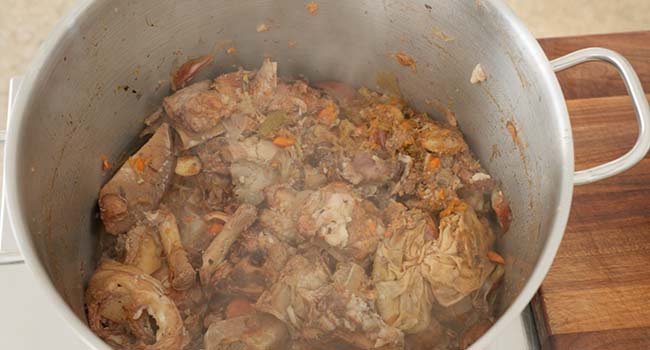
Add the water: I completely cover the bones with 2 to 2 ½ gallons of cold water. I make sure the water sits at least 2 inches above the bones but not more than 4.

Add the aromatics: Next, I add the onions, celery, carrots, thyme, parsley, peppercorns, and garlic. You can also place the spices and herbs on a 1 x 1 square foot piece of cheesecloth. Fold up the corners and securely tie a double knot around it using butcher’s twine to ensure nothing comes out. As a note, if you plan on using a chinois to drain everything, you can place everything in the cheesecloth and put it into the pot.
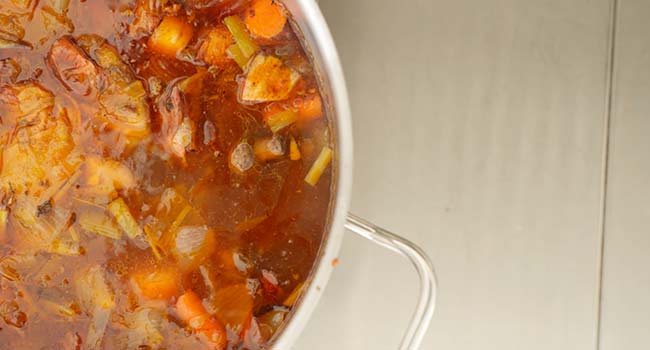
Simmer the stock: I let the remouillage simmer on low to medium heat for 3 to 6 hours. The timing of this cook will depend on how much you cooked the initial stock for. If you cooked the first stock for 6 hours, you could cook the remouillage for up to 6. If you cooked the first stock for 8 hours plus, you will only get as much flavor from the remouillage as possible in 3 or so hours. Come back every hour to skim and discard any impurities or fat that collects at the top using a ladle.
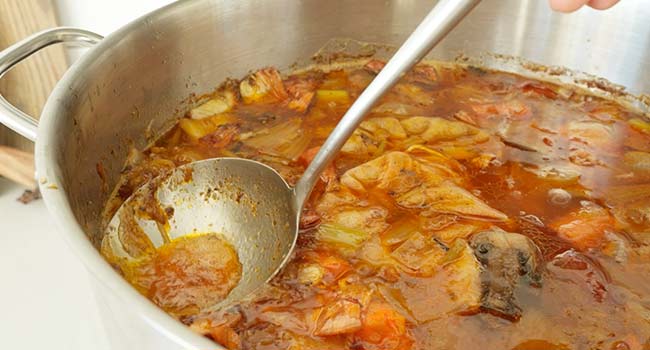
Strain the stock: Once it’s done simmering, I carefully strain the stock using a chinois, fine mesh strainer, or a layer of cheesecloth to catch any solids and leave me with a clear liquid.
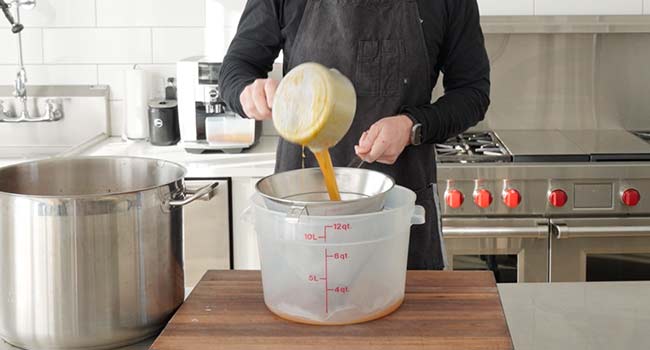
Store or use: I either use the remouillage right away in soups or sauces, or let it cool and store it in the fridge or freezer for another time.


Chef Tip + Notes
A humble piece of advice for making my Remouillage recipe is to skim the top every hour while it simmers. It might seems like a minor detail, but it really helps keep the stock clean and the flavor pure.
- Make a small sauce: I like to use remouillage as a base for small sauces by building on it with other ingredients. For example, I start with veal stock, make espagnole, and then turn it into a rich demi-glace.
- Compost the bones: After I strain the stock, the bones are usually soft and broken down. I often add them to my garden compost to help enrich the soil.
- Cool it properly: After I strain the remouillage, I let it cool completely before storing it. This helps prevent condensation in containers and keeps the flavor fresh.
- Label and date: When I freeze remouillage, I always label and date the container. That way, I know exactly how long it’s been stored and what I’m working with.
How to Use Remouillage
There are many ways I like using remouillage, including replacing regular veal stock or beef stock. It works well in any soup, like my beef and barley or birria consomé. The stock that comes from this process will be gelatinous enough for you to continue reducing it down to a glaze that you can use for sauces.
Make-Ahead and Storage
Make-Ahead: You can make this up to 2 days ahead. Store it according to the directions below.
How to Store: Cool, cover, and keep the remouillage in a container for up to 5 days. This will freeze well in large or smaller containers for up to 6 months. Thaw it in the fridge for 1 day before reheating.
How to Reheat: Add the desired amount of remouillage to a pot and heat over low to medium heat until warm.
Comfort Food Classics Made Better with Remouillage

How to Make a Remouillage

Ingredients
- 16 pounds of leftover cooked veal or beef bones
- 4 roughly chopped yellow onions, weighing a total of 1 pound
- 4 roughly chopped ribs of celery, weighing a total of 8 ounces
- 4 peeled or unpeeled roughly chopped carrots, weight a total of 8 ounces
- 4 to 6 sprigs of thyme
- 4 to 6 parsley stems
- 15 to 18 peppercorns
- 3 to 4 garlic cloves
Instructions
- Once you’ve completely drained the stock, return the bones, cooked mirepoix, spices, and herbs in the pot and onto the cooktop.
- Completely cover the bones in 2 to 2 ½ gallons of cold water. The water should cover the bones by at least 2 inches, but no more than 4.
- Next, add in the onions, celery, carrots, thyme, parsley, peppercorns, and garlic. You can also place the spices and herbs on a 1 x 1 square foot piece of cheesecloth. Fold up the corners and securely tie a double knot around it using butcher’s twine to ensure nothing is coming out. As a note, if you plan on using a chinois to drain everything, you can just place everything in the cheesecloth into the pot.
- Simmer the stock of low to medium heat for 3 to 6 hours. The timing of this cook will depend on how much you cooked the initial stock for. If you cooked the first stock for 6 hours, you could cook the remouillage for up to 6. If you cooked the first stock for 8 hours plus, then you only will be able to get as much flavor from the remouillage as possible in 3 or so hours.
- Come back every hour to skim and discard any impurities or fat that collects at the top using a ladle.
- Strain the stock completely using a chinois, fine mesh strainer, or cheesecloth.
- Use it, or store in the fridge or freezer for a later date.


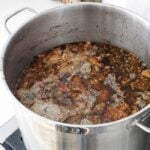

How to Make a Remouillage